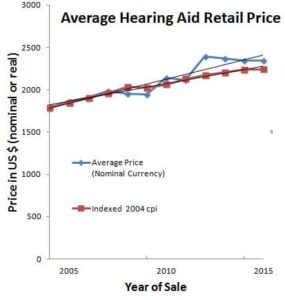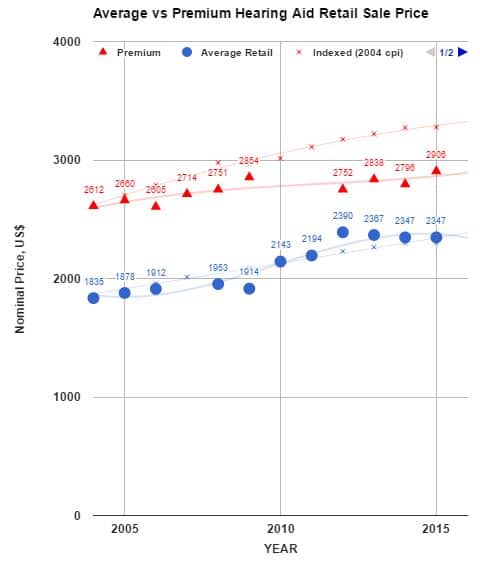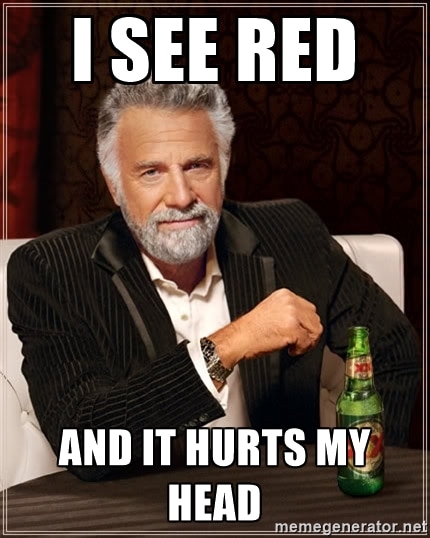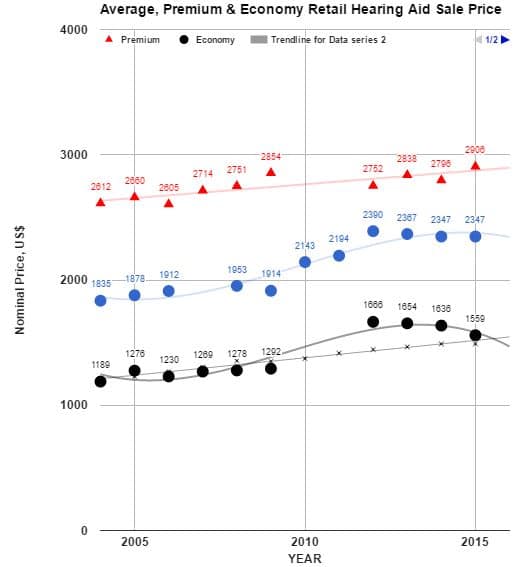
Figure 1. Average retail price of hearing aids in US, 2004 to 2016, shown in nominal and inflation-adjusted dollars
by Holly Hosford-Dunn, PhD & Amyn Amlani, PhD
Average Sale Price of hearing aids in the US retail market (ASP) grew at the rate of inflation from 2004-2011, peaked in price in 2012 and declined each year thereafter. At no time has ASP ever hit $6K/set, no matter how many times that anchor price gets bandied around.
These are the data-driven conclusions of Hearing Economics, published June 16, 2016 and shown in Fig 1 in that post and again today. They anchor our thinking until better data emerge to convince otherwise. For readers’ convenience today’s long post pulls all retail Price data together in one place, shown in three figures.
This Hurts Our Heads
And yet…a few otherwise well-informed, serious students of hearing persist in promulgating and inflating the $6K anchor. Consider this unsubstantiated set of facts in an otherwise good article from a journalist writing in the Huffington Post three days ago:
What’s the Number One reason people say they don’t wear hearing aids?
Cost.
A single hearing aid costs between $3000 and $4000 and most people with age- or noise-related hearing loss need two. (Bouton, 2016)1
True, most US adults with acquired hearing loss are better off with two instruments.
Not true that cost is the #1 reason for under-consumption, at least based on widely-accepted national consumer surveys and government statistics.2
Not true that they cost $3K each, much less $4K.
No doubt someone somewhere is gouging consumers for even more than $4K/aid. Outliers and carpetbaggers are not the average, but they’re all the more reason to encourage economic rationality in consumers and those who write about them. Data helps and everyone can help make the data better.
All journalists, consumers, academics and others in need of facts and fact checking are encouraged, actually begged, to refer to Figs 1-3 in today’s post and future figures in this series. All are encourage to use these figures with abandon when purchasing hearing aids or writing about hearing aids. As always, all are encouraged to contribute data and suggestions to improve the graphs.
Hearing Aids: Premium Product Retail Price
The $6K-and-Rising price assumptions could be natural by-products of basic market dynamics, including so-called “silver bullets” in the hearing aid industry. Since 1994, technological innovations that differentiate manufacturers’ products come with R&D price tags that keep the price of premium products high when they’re first put on the market, as shown in Fig 2, and described in detail in the 2013 Price series.

Figure 2. ASP (all aids) tracked inflation for most of the last decade. Premium product pricing did not, falling further below inflation most successive years.
Premium products account for a relatively small (<30%) and decreasing proportion of total US annual hearing aids sales, but the high sticker price is sure to anchor in the minds of consumers and those who sell to them, just as it does for high priced luxury vehicles. A quick glance at Figure 2 (and a review of the 2013/2014 Pricing series) shows that nominal Price3 of premium price hearing aids has acted a lot like the anchor price for the last decade, staying stuck near the $3K mark. Mystery solved and some vindication for those who rely on hearsay.
That’s a simple and fun discovery, but a closer look at Figure 2 yields more meaningful information for informing consumers and social policy mavens:
- More affordable Cadillacs. Since 2004, Price of premium product has gotten less expensive every year for consumers. On average, it rose just $27/year in actual currency, compared to the $60/year needed to keep up with inflation. That’s seen in Figure 2 by comparing nominal and real price (red diamonds versus red x’s).Based on growth in the consumer price index (cpi)4 since 2004, the Price of a premium hearing aid in today’s market should average about $3277. Instead, consumers can purchase one for $370 less than it cost them in real dollars a decade ago. They’re still Cadillacs, but they’re within reach of more consumers than in the past.
- Chevy’s aren’t getting cheaper. Price range for hearing aids is converging due to deflationary retail pricing of premium product while ASP (all product) keeps pace with inflation (see Fig 1 and blue functions in Fig 2).
Hearing Aid: Basic/Economy Product Retail Pricing
On the bottom of the consumer choice spectrum, low-end hearing aids are contributing to Price convergence Figure 3 completes the retail Price data by adding in nominal and inflation-adjusted price functions for Economy class instruments (black squares and x’s, respectively).
These data are harder to come by, in part because the definition of what constitutes “basic” or “economy” keeps changing as technological innovations leap-frog one another. Figure 3 tells us a few more things about Price:
- A Kia costs more nowadays. And so does an economy hearing aid. It seems safe to say that Economy class instruments have outpaced inflation for at least the last five years, but the trend is lessening as Price for this category continues a downward trend since 2012. In other words, it has cost consumer more to buy such instruments, on average, in recent years, compared to 2004, but not by much in 2015. Added to that, the fact that an Economy class instrument in 2015 is light years ahead of anything available at any price point in 2004 is beyond argument but probably does not assuage the demand for less expensive hearing aids in today’s market.
- Price range contracted. The gap between a Premium and Economy instrument was at its narrowest in 2014 –over $350 less than it was in 2004. The gap in 2015 is wider, but still $75 less for consumers than in 2004.
Up Next
None of the above addresses the call for a “basic” hearing aid that is available over the counter. Those come without benefit of professional fitting but without the added cost of services bundled into Price. As described in 2013, they’ve been available at very low cost (e.g., $399) for years on the Internet or by mail. A quick Google search confirms that a plethora of “basic” instruments can be had without regulatory difficulty by consumers for far lower Price than is shown in Figs 1-3. That market is not included in our series due to the ease of search, price transparency, wide range of suppliers and wide range of quality of product.
Wholesale Price for the three categories of Figs 1 – 3 is the next step in this series as we find out what’s bundled into the retail prices and whether times have changed since Wholesale Price was last visited in 2013.
References and Footnotes:
1Bouton K. Want hearing aids? Too expensive? Read on. The Huffington Post, June 25, 2016.
2This is an extensive topic which deserves its own post to bring together data from MarkeTrak surveys, CTA 2014 PSAP survey, and adoption rates in the VA and in other countries where hearing aids are free or subsidized.
3CPI is the basket of goods used for economic analyses. CPI is composed of a representative group of commodities, undifferentiated goods that change slowly or not at all (e.g., wheat/food) over time. The basket is periodically updated by adding or discarding items. Click here for a previous post in the 2013 series that explained nominal vs real dollars; purchasing power and cpi.
This is Part 2 of the 2016 Hearing Aid Price Series update. Click here for Part 1 and Part 3.
2016 Pricing Series is co-written by Amyn M. Amlani, Ph.D. Dr Amlani is an Associate Professor on the faculty of the Department of Speech and Hearing Sciences, University of North Texas. Dr. Amlani holds the B.A. degree in Communication Disorders from the University of the Pacific, the M.S. degree in Audiology from Purdue University, and the Ph.D. degree in Audiology/Psychoacoustics (minor in Marketing and Supply Chain Management) from Michigan State University. His research interests include the influence of hearing aid technology on speech and music; economic and marketing trends within the hearing aid industry; and playing bass guitar with The Moonlighters, a heavy metal cover band.
*feature image courtesy of meme generator










Holly, Thanks for noting my Huffington Post blog.
A few comments in response to your criticisms.
On cost:
The October 26, 2015 report from the President’s Council on Science and Technology stated that the average price for one hearing aid was more than $2300. This is hearing aids at all levels, from the most basic up.
Hearing Review noted in 2013 that the average price for a high end hearing aid (http://www.hearingreview.com/2014/04/hr-2013-hearing-aid-dispenser-survey-dispensing-age-internet-big-box-retailers-comparison-present-past-key-business-indicators-dispensing-offices/), is $1694 to $2,993. This is an average, which means that many many high-end hearing aids cost more than $3000. Any American consumer will tell you that a high end hearing aid bought from an independent audiologist rarely costs less than $3300 and often costs more. This is one reason for the surge in interest in stores like Costco as hearing-aid retailers.
As for the number one reason for not buying hearing aids, in the United States, that is indisputably cost, with those with the most severe hearing loss being most affected by high cos:
Marke Trak IX: “The most common reasons people do not buy hearing aids and/or take action are financial constraints and lack of a perceived need. … The non-owners with more severe hearing loss often have greater financial constraints, making it more difficult to purchase hearing aids compared to those with moderate losses who tend to have fewer financial barriers.”
It may well be true that in countries with subsidized health care, cost is not the number one issue. But in the United States, where hearing aids are not covered by insurance — not Medicare, not Medicaid, not private insurance — and where the “average” — for all levels of hearing aids from the most basic to the most sophisticated — is $2300, cost is certainly the major factor.
Hello Katherine and thanks for joining in the discussion. The numbers you mention are factored into the data base from which Figs 1 – 3 arrive at actual values. It is very difficult to take a single number from a single source, which itself has probably done the same thing, and arrive at conclusions that describe the market accurately. If we could do that, economics would be out of business! As for cost being the indisputable #1 factor, once again it is necessary to look at all factors affecting Utility and consumer preference within the market prior to concluding that one factor dominates. That is something we will be working through in detail, using wide-spread data gathering in future posts. Ours was not a critique of your article which, as mentioned, was well written and considered in general; rather it was a plea to those who have influence, such as yourself, to be judicious when using specific numbers out of context. As you mention, and we do too in the post, the PCAST selection of $2400/aid is quite close to the average retail price of aids (all types) in present times, so there is little (probably no) disagreement in that regard. We also point out that premium aid average Price has been close to the $3000/aid mark for a decade now, in nominal dollars, so there is no disagreement in that regard, either, so long as writers are careful to stipulate the category of aid. Again, thank you for your Comment which furthers the discussion. That, not defending Price, is our goal and your article indicates that you share that goal. Best, Holly & Amyn
Thanks Holly. Your column — and HHTM in general — is an invaluable resource for those of us interested in the hearing health field.
One difference between your writing and mine is that — especially in that HuffPost column — I am writing for people who know nothing about hearing loss. You are writing for those of us who follow the field closely. We really appreciate your precision.
My intention with HuffPost readers is to get them to sit up and pay attention. That said, I could have been a little more conservative with figures. But I really do hear fairly frequently about people paying up to $5000 for a single hearing aid. I agree, it’s outrageous.
Katherine
Here are my comments, filed with the FDA, regarding PCAST’s recommendations and some of the flawed assumptions that they were based on, including cost. The source of their $3000/aid “average” was extensively discussed by the study authors/conductors themselves as probably being too high. But you had to read the study itself, not just PCAST’s report, to get that information.
https://behearnowblog.wordpress.com/2016/05/07/comments-filed-with-fda-on-hearing-device-recommendation/
correction: I meant $2400, not $3K.
In a Clinton government we could find total control on pricing of hearing aids, with peaks for premium hearing aids at about $4800 (pair). If this legislation passes you may find total control of product and pricing, like in Universal healthcare.We, as hearing aid professionals will suffer the most. The manufacturers wont be affected because to them, a $99 premium aid would be still jacked up to $889 each. The consumer will also benefit due to the price reduction.
Bottom line: Don’t vote for a liberal or Communist this time. Keep the market as free as possible.